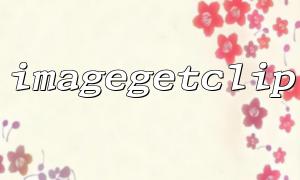During PHP image processing, we often need to copy a portion of the image from one resource to another. The imagecopy function has long been an old friend in image processing, while imagegetclip is a relatively rarely used but very practical function. Have you ever wondered what flexibility and powerful functions these two functions can bring to your image processing operations when combined? This article will give you an in-depth understanding of how to use imagegetclip and imagecopy to achieve accurate image clipping and copying operations.
imagegetclip is a function in the GD library used to obtain the current image clipping region. It returns an array containing four boundary values of the image cropping area: x , y , width , and height . This is very useful when you need to dynamically judge or reuse crop areas.
$clip = imagegetclip($srcImg);
print_r($clip);
Output example:
Array
(
[x] => 0
[y] => 0
[width] => 200
[height] => 150
)
imagecopy is a function used to copy part of the source image to the target image, and its prototype is as follows:
bool imagecopy(
GdImage $dst_image,
GdImage $src_image,
int $dst_x,
int $dst_y,
int $src_x,
int $src_y,
int $src_width,
int $src_height
)
It can be copied into the target image based on coordinates and width and height, and is an indispensable tool in image stitching and thumbnail production.
Let's look at a practical application scenario: You want to crop an area from the source image and copy it to a specific location in another image. This area is not fixed, but depends on the cropped area of the current image. At this time, you need to use imagegetclip to get the cropped area first, and then copy it with imagecopy .
// Load source and target images
$srcImg = imagecreatefromjpeg('https://gitbox.net/images/source.jpg');
$dstImg = imagecreatetruecolor(300, 300);
// Get the cropped area of the source image
$clip = imagegetclip($srcImg);
// Use information on the crop area imagecopy operate
imagecopy(
$dstImg, // Target image
$srcImg, // Source image
50, 50, // Target image上的位置
$clip['x'], // Source image开始的 x coordinate
$clip['y'], // Source image开始的 y coordinate
$clip['width'], // Width of the copy area
$clip['height'] // The height of the copy area
);
// Output image
header('Content-Type: image/jpeg');
imagejpeg($dstImg);
// Free up resources
imagedestroy($srcImg);
imagedestroy($dstImg);
Setting of crop area : If imagesetclip was used before to limit the operation area of the image, imagegetclip will return to the set area. Make sure you understand the current cropping context.
Image format compatibility : Different image format loading functions are different. For example, PNG uses imagecreatefrommpng to ensure that it matches the source image format.
Transparent background processing : If the target image is PNG and needs to retain a transparent background, use imagesavealpha and imagealphableending .
The combination of imagegetclip and imagecopy provides a more flexible way to PHP image processing. By obtaining cropped areas and accurately copying, more complex image processing logic can be achieved, such as regional mosaics, local blur, image stitching, etc. Learning this technique can greatly improve your efficiency and accuracy in processing images.
In the world of image processing, details determine success or failure. I hope that through this article, you will have a deeper understanding of the combination of these two functions. If you are building online image tools like https://gitbox.net/tools/crop-editor , this trick is definitely an essential part.





